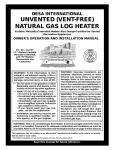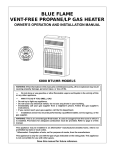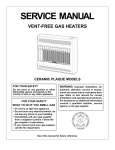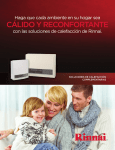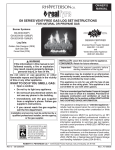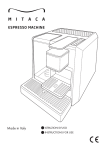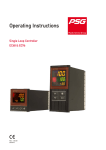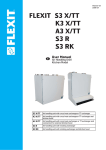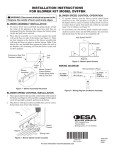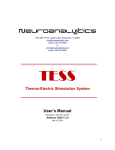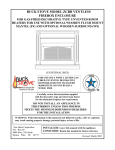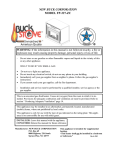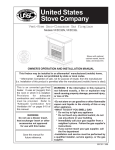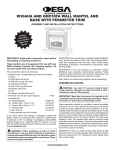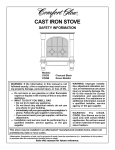Download Vanguard FBST User's Manual
Transcript
® UNVENTED (VENT-FREE) LogMate® Universal FireBOX OWNER’S OPERATION AND INSTALLATION MANUAL Model FBST 36" See-Thru Heat-Circulating Firebox WARNING: If the information in these instructions is not followed exactly, a fire or explosion may result causing property damage, personal injury or death. FOR YOUR SAFETY — Do not store or use gasoline or any other flammable vapors or liquids in the vicinity of this or any other appliance. — WHAT TO DO IF YOU SMELL GAS : • Do not try to light any appliance. • Do not touch any electrical switch; • Do not use any phone in your building. • Immediately call your gas supplier from a neighbor’s phone. Follow the gas supplier’s instructions. • If you cannot reach your gas supplier, call the fire department. — Installation and service must be performed by a qualified installer, service agency or the gas supplier. Save this manual for future reference. For more information, visit www.desatech.com WARNING: Improper installation, adjustment, alteration, service or maintenance can cause injury or property damage. Refer to this manual for correct installation and operational procedures. For assistance or additional information consult a qualified installer, service agency or the gas supplier. WARNING: For use only with decorative type unvented room heaters. Do not build a wood fire. This firebox has been tested and approved by I.A.S. under their REQ. 2-97 for use with any ANS Z21.11.2 approved gas logs. This firebox may be installed in an aftermarket*, permanently located, manufactured (mobile) home, where not prohibited by state or local codes. *Aftermarket: Completion of sale, not for purpose of resale, from the manufacturer. State of Massachusetts: The installation must be made by a licensed plumber or gas fitter in the Commonwealth of Massachusetts. Sellers of unvented propane or natural gas-fired supplemental room heaters shall provide to each purchaser a copy of 527 CMR 30 upon sale of the unit. Vent-free gas products are prohibited for bedroom and bathroom installation in the Commonwealth of Massachusetts. TABLE OF CONTENTS Safety Information................................................ 3 Product Specifications.......................................... 4 Local Codes......................................................... 4 Unpacking............................................................ 4 Product Features.................................................. 4 Locating Firebox .................................................. 5 Air for combustion and Ventilation........................ 5 Installation............................................................ 8 Operating Guidelines and Maintenance Instructions.............................. 15 Replacement Parts............................................. 15 Illustrated Parts Breakdown and Parts List........ 16 Technical Service............................................... 18 Accessories........................................................ 18 Warranty Information............................Back Cover www.desatech.com 105116-01D Safety Information IMPORTANT: Read this owner’s manual carefully and completely before trying to assemble, operate or service this firebox. Improper use of this firebox can cause serious injury or death from burns, fire, explosion, electrical shock or carbon monoxide poisoning. CAUTION: Carefully review the instructions supplied with the decorative type unvented room heater for the minimum firebox size requirement. Do not install the appliance in this firebox unless this firebox meets the minimum dimensions required for the installation. WARNING: Any change to this firebox or its controls can be dangerous. WARNING: Do not use a blower insert, heat exchanger insert or other accessory not approved for use with this firebox. Do not allow fans to blow directly into the firebox. Avoid any drafts that alter burner flame patterns. Ceiling fans can create drafts that alter burner flame patterns. Altered burner patterns can cause sooting. Firebox front and screen becomes very hot when running firebox. Keep children and adults away from hot surfaces to avoid burns or clothing ignition. Firebox will remain hot for a time after shutdown. Allow surfaces to cool before touching. 105116-01D Carefully supervise young children when they are in the room with firebox. You must operate this fireplace with the provided fireplace screen, hood and brick liner in place. Make sure these parts are in place and screens are closed before running firebox. The supplied hoods may not be replaced with hoods which may be provided with a log heater. Keep the appliance area clear and free from combustible materials, gasoline and other flammable vapors and liquids. 1. This firebox shall not be installed in a bedroom or bathroom. 2. Never install the firebox •in a recreational vehicle •where curtains, furniture, clothing or other flammable objects are less than 42" from the front, top or sides of the firebox •in high traffic areas •in windy or drafty areas 3. Do not use this firebox as a wood-burning fireplace. Use only decorative unvented room heaters (log sets). 4. Do not add extra logs or ornaments such as pine cones, vermiculite or rock wool. Using these added items can cause sooting. 5. Use only the provided hoods or appropriate polished brass hood accessories. See Accessories on page 18. 6. Vent-free gas log heaters installed in this firebox require fresh air ventilation to run properly. See Air for Combustion and Ventilation, page 5. 7. Do not run firebox •where flammable liquids or vapors are used or stored •under dusty conditions 8. Do not use this firebox to cook food or burn paper or other objects. 9. Never place any objects in firebox or on logs. 10. Turn firebox off and let cool before servicing. Only a qualified service person should service and repair firebox. 11. Operating vent-free logs in a firebox above elevations of 4,500 feet could cause pilot outage. www.desatech.com Safety Information Continued 12. Do not use the firebox if it has been under water due to the shock hazard that could result with the blower accessary (if installed) in place. 13. Provide adequate clearances around air openings. Local Codes Install and use firebox with care. Follow all local codes. In the absence of local codes, use the latest edition of The National Fuel Gas Code ANS Z223.1/NFPA 54*. Firebox must be electrically grounded in accordance with the National Electrical Code, ANS/NFPA70 (latest edition). *Available from: American National Standards Institute, Inc. 1430 Broadway New York, NY 10018 National Fire Protection Association, Inc. Batterymarch Park Quincy, MA 02269 Blower Accessory The FBST firebox will accept the GA3500A accessory. The variable blower allows you to select the fan speed you desire. The blower circulates heated air from the firebox into the room. Use of blower is optional. Brick Liner This firebox features a concrete brick liner. As with all concrete liners, this liner may develop slight cracks when exposed to heat. These cracks will not affect the performance of the firebox or vent-free gas logs. Product Specifications 1 1/4" 24" 1/2" 5/8" Unpacking 1. Remove all protective packaging from inside firebox. Carefully lift the firebox off the bottom corrugated tray. 2. Carton should contain 2 deflective hoods and hardware packet in addition to firebox assembly. If items are missing, inform dealer where you bought firebox. 1 1/4" 3. Check all items for any shipping damage. If damaged, promptly inform dealer where you bought firebox.24" NOTICE: The firebox identification label (including model number, serial number, clearances, etc.) is located directly above 4 /" the brick liner 1 / "and under the heat shield. See Figure 20, page 15. 3 1 4 3 5/8" 4 1/4" 1 3/4" 3" TYP. 20 1/2" 18 1/2" 40" 36 1/4" 9 1/8" 1/2" 36 1/2" 5/8" 42 1/2" 44 1/4" 3 5/8" 4" 4 3" TYP. Product Features Operation 18 1/2" 20 1/2" This firebox is designed 36 /4" for use with approved ANS Z21.11.2 decorative type unvented room heaters. (Physical size limitations 9 1/8"apply. Refer to minimum firebox requirements supplied with log heater.) It 36 1/2" inrequires no outside venting or chimney making 1 42 stallation easy and inexpensive. When used/2"without 44 1/4" the blower, the firebox requires no electricity making it ideal for emergency backup heat. 1 19 1/2" 40" 5 1/2" 5 12" 2 1/4" Figure 1 - Dual-Sided Firebox www.desatech.com 105116-01D 19 1/2 Locating Firebox Planning Plan where you will install the firebox. This will save time and money later when you install the firebox. Before installation, consider the following: 1. Where the firebox will be located. Allow for wall and ceiling clearances (see Installation Clearances, page 8). 2. Everything needed to complete installation. 3. These models CANNOT be installed in a bedroom or bathroom. 4. Proper air for combustion and ventilation. 5. Consider a location where heat output would not be affected by drafts, air condition ducts, windows or doors. 6. A location that minimizes modifications on existing framing will make installation easier. Projected installations can extend any distance into the room. A projection may be ideal as a partition between two otherwise common areas when added to an existing, finished wall (see Figure 2). Internal wall installation provides a discreet viewing option between two adjacent rooms or within an added wall to subdivide an oversize room. Air for combustion and Ventilation WARNING: This firebox shall not be installed in a confined space or unusually tight construction unless provisions are provided for adequate combustion and ventilation air. Read the following instructions to insure proper fresh air for this and other fuel-burning appliances in your home. Today’s homes are built more energy efficient than ever. New materials, increased insulation and new construction methods help reduce heat loss in homes. Home owners weather strip and caulk around windows and doors to keep the cold air out and the warm air in. During heating months, home owners want their homes as airtight as possible. While it is good to make your home energy efficient, your home needs to breathe. Fresh air must enter your home. All fuel-burning appliances need fresh air for proper combustion and ventilation. Exhaust fans, fireboxes, clothes dryers and fuel burning appliances draw air from the house to operate. You must provide adequate fresh air for these appliances. This will insure proper venting of vented fuel-burning appliances. PROVIDING ADEQUATE VENTILATION Figure 2 - Projected Installation The following are excerpts from National Fuel Gas Code ANS Z223.1/NFPA 54, Section 5.3, Air for Combustion and Ventilation. All spaces in homes fall into one of the three following ventilation classifications: 1. Unusually Tight Construction 2. Unconfined Space 3. Confined Space The information on pages 5 through 7 will help you classify your space and provide adequate ventilation. Unusually Tight Construction The air that leaks around doors and windows may provide enough fresh air for combustion and ventilation. However, in buildings of unusually tight construction, you must provide additional fresh air. 105116-01D www.desatech.com AIR FOR COMBUSTION AND VENTILATION Continued Unusually tight construction is defined as construction where: a. walls and ceilings exposed to the outside atmosphere have a continuous water vapor retarder with a rating of one perm (6 x 1011 kg per pa-sec-m2) or less with openings gasketed or sealed and b. weather stripping has been added on openable windows and doors and c. caulking or sealants are applied to areas such as joints around window and door frames, between sole plates and floors, between wall-ceiling joints, between wall panels, at penetrations for plumbing, electrical and gas lines and at other openings. If your home meets all of the three criteria above, you must provide additional fresh air. See Ventilation Air From Outdoors, page 7. If your home does not meet all of the three criteria above, proceed to Determining Fresh-Air Flow for Firebox Location. Confined and Unconfined Space The National Fuel Gas Code ANS Z223.1/NFPA 54 defines a confined space as a space whose volume is less than 50 cubic feet per 1,000 Btu per hour (4.8 m3 per kw) of the aggregate input rating of all appliances installed in that space and an unconfined space as a space whose volume is not less than 50 cubic feet per 1,000 Btu per hour (4.8 m3 per kw) of the aggregate input rating of all appliances installed in that space. Rooms communicating directly with the space in which the appliances are installed*, through openings not furnished with doors, are considered a part of the unconfined space. This heater shall not be installed in a confined space or unusually tight construction unless provisions are provided for adequate combustion and ventilation air. * Adjoining rooms are communicating only if there are doorless passageways or ventilation grills between them. DETERMINING FRESH-AIR FLOW FOR Firebox LOCATION Determining if You Have a Confined or Unconfined Space Use this work sheet to determine if you have a confined or unconfined space. Space: Includes the room in which you will install heater plus any adjoining rooms with doorless passageways or ventilation grills between the rooms. 1. Determine the volume of the space (length x width x height). Length x Width x Height =__________cu. ft. (volume of space) Example: Space size 22 ft. (length) x 18 ft. (width) x 8 ft. (ceiling height) = 3168 cu. ft. (volume of space) If additional ventilation to adjoining room is supplied with grills or openings, add the volume of these rooms to the total volume of the space. 2. Multiply the space volume by 20 to determine the maximum Btu/Hr the space can support. ___________ (volume of space) x 20 = (Maximum Btu/Hr the space can support) Example: 3168 cu. ft. (volume of space) x 20 = 63,360 (maximum Btu/Hr the space can support) 3. Add the Btu/Hr of all fuel burning appliances in the space. Gas water heater* ______________Btu/Hr Gas furnace ______________Btu/Hr Vented gas heater ______________Btu/Hr Gas fireplace logs ______________Btu/Hr Other gas appliances* +_____________Btu/Hr Total =_____________Btu/Hr * Do not include direct-vent gas appliances. Direct-vent draws combustion air from the outdoors and vents to the outdoors. Example: 40,000 Gas water heater ______________Btu/Hr 39,000 Gas firebox logs +_____________Btu/Hr 79,000 Total =_____________Btu/Hr 4. Compare the maximum Btu/Hr the space can support with the actual amount of Btu/Hr used. __________Btu/Hr (maximum the space can support) __________Btu/Hr (actual amount of Btu/Hr used) Example: 63,360 Btu/Hr (maximum the space can support) 79,000 Btu/Hr (actual amount of Btu/Hr used) www.desatech.com 105116-01D AIR FOR COMBUSTION AND VENTILATION Continued The space in the above example is a confined space because the actual Btu/Hr used is more than the maximum Btu/Hr the space can support. You must provide additional fresh air. Your options are as follows: A. Rework work sheet, adding the space of an adjoining room. If the extra space provides an unconfined space, remove door to adjoining room or add ventilation grills between rooms. See Ventilation Air from Inside Building. B. Vent room directly to the outdoors. See Ventilation Air from Outdoors. C. Install a lower Btu/Hr gas log heater, if lower Btu/Hr size makes room unconfined. If the actual Btu/Hr used is less than the maximum Btu/Hr the space can support, the space is an unconfined space. You will need no additional fresh air ventilation. WARNING: If the area in which the firebox and gas log heater may be operated is smaller than that defined as an unconfined space or if the building is of unusually tight construction, provide adequate combustion and ventilation air by one of the methods described in the National Fuel Gas Code, ANS Z223.1/NFPA 54, Section 5.3 or applicable local codes. WARNING: Rework worksheet, adding the space of the adjoining unconfined space. The combined spaces must have enough fresh air to supply all appliances in both spaces. Ventilation Grills Into Adjoining Room, Option 1 Or Remove Door into Adjoining Room, Option 2 Figure 3 - Ventilation Air from Inside Building Ventilation Air From Outdoors Provide extra fresh air by using ventilation grills or ducts. You must provide two permanent openings: one within 12" of the ceiling and one within 12" of the floor. Connect these items directly to the outdoors or spaces open to the outdoors. These spaces include attics and crawl spaces. Follow the National Fuel Gas Code ANS Z223.1/NFPA 54, Section 5.3, Air for Combustion and Ventilation for required size of ventilation grills or ducts. IMPORTANT: Do not provide openings for inlet or outlet air into attic if attic has a thermostatcontrolled power vent. Heated air entering the attic will activate the power vent. Ventilation Air Ventilation Air From Inside Building This fresh air would come from an adjoining unconfined space. When ventilating to an adjoining unconfined space, you must provide two permanent openings: one within 12" of the ceiling and one within 12" of the floor on the wall connecting the two spaces (see option 1, Figure 3). You can also remove door into adjoining room (see option 2, Figure 3). Follow the National Fuel Gas Code ANS Z223.1/NFPA 54, Section 5.3, Air for Combustion and Ventilation for required size of ventilation grills or ducts. 105116-01D Outlet Air Outlet Air Ventilated Attic To Attic To Crawl Space Inlet Air Inlet Air Ventilated Crawl Space Figure 4 - Ventilation Air from Outdoors www.desatech.com Installation NOTICE: This firebox in combination with unvented log sets are intended for use as supplemental heat. Use along with your primary heating system. Do not install them as your primary heat source. If you have a central heating system, you may run system’s circulating blower while using heater. This will help circulate the heat throughout the house. In the event of a power outage, you can use unvented logs as your primary heat source. WARNING: A qualified service person must install firebox. Follow all local codes. WARNING: Never install the firebox • in a bedroom or bathroom • in a recreational vehicle • where curtains, furniture, clothing or other flammable objects are less than 42" from the front, top or sides of the firebox • in high traffic areas • in windy or drafty areas CAUTION: Log heaters installed in this firebox create warm air currents. These currents move heat to wall surfaces next to firebox. Installing firebox next to vinyl or cloth wall coverings or operating firebox where impurities (such as, but not limited to, tobacco smoke, aromatic candles, cleaning fluids, oil or kerosene lamps, etc.) in the air exist, may discolor walls or cause odors. IMPORTANT: Vent-free gas log heaters add moisture to the air. Although this is beneficial, installing firebox in rooms without enough ventilation air may cause mildew to form from too much moisture. See Air for Combustion and Ventilation, page 5. IMPORTANT: Make sure the firebox is level. If firebox is not level, log set will not work properly. Note: Your Vanguard firebox is designed to be used in zero clearance installations. Wall or framing material can be placed against any exterior surface on the rear, sides or top of your firebox, except where standoff spacers are integrally attached. If standoff spacers are attached to your firebox, these spacers can be placed directly against wall or framing materials. Use dimensions shown for rough openings to create the easiest installation (see Built-In Firebox Installation, page 9). INSTALLATION CLEARANCES WARNING: Maintain the minimum clearances. If you can, provide greater clearances from floor, ceiling and adjoining wall. Carefully follow the instructions below. This will ensure safe installation. Minimum Wall and Ceiling Clearances A. Clearances from the side of the firebox opening to any combustible wall should not be less than 8 ". B. Clearances from the top of the firebox opening to the ceiling should not be less than 42". C. When the firebox is installed on carpeting or other combustible material, other than wood flooring, the firebox should be installed on a metal or wood panel extending the full width and depth of the enclosure. D. Clearances from the bottom of firebox to the floor is 0". CAUTION: Do not install the firebox directly on carpet or vinyl. CAUTION: Use only the clearances specified in this manual or on the firebox rating plate. www.desatech.com 105116-01D INSTALLATION Continued Minimum clearances to combustibles are: • Sides of outer casing 0" min. • Drywall to sides and top of 0" min. front face • Ceiling to opening 42' min. • Floor (see Minimum Wall 0" min. and Ceiling Clearances, note C) • Perpendicular walls 4' min. Right and Left • Distance to Facing Walls 36" min. See Figures 5 and 6. Ceiling 0" Min. Clearance to Upper Frame/Wallboard 42" Min. CAUTION: Do not allow the vent-free gas log heater to touch or extend beyond the firebox screen. If your installation does not meet the above minimum clearances in Figure 7, you must: • raise the mantel to an acceptable height, OR • remove the mantel. Wall board or facing material (above firebox) may be of combustible material, including decorative mantel ornaments or other similar projections off of the facing material. Top Frame (Combustible Material) Mantel Shelf 9 1/4" 8" Min. 6" 3" Firebox Top 0" to Wood Floor Figure 5 - Minimum Clearance Front View Wire-mesh Screen 1/2" Min. Clearance to Combustibles Combustible Material 1 1/2" 12" 15" 18" Max Thickness Note: Do not 7" Min. cover louver openings. Note: All vertical measurements are from top of fireplace Supplied hood to bottom of Firebox Hoods mantel shelf. These Must Be Used minimum clearances replace any other at All Times recommended clearances supplied with your ANS Z21.11.2 approved gas logs. Figure 7 - Minimum Mantel Clearances for Built-In Installation 24" 44 1/4" 4" Min. from the Perpendicular Side Wall to the Edge of Facial Figure 6 - Minimum Clearance - Top View Mantel Clearances for Built-In Installation If placing custom mantel above built-in firebox, you must meet the minimum allowable clearance between mantel shelf and top of firebox opening shown in Figure 7. These are the minimum allowable mantel clearances for a safe installation. Use larger clearances wherever possible to minimize the heating of objects and materials placed on the mantel. 105116-01D Built-In Firebox Installation Built-in installation of this firebox involves installing firebox into a framed-in enclosure. This makes the front of firebox flush with wall. Optional perimeter brass trim accessories are available (see Accessories, page 18). The brass trim will extend past sides of firebox approximately 1/2". This will cover the rough edges of the wall opening. If installing a mantel above the firebox, you must follow the clearances shown in Figure 7. Follow the instructions below to install the firebox in this manner. 1. Frame in rough opening. The firebox framing should be constructed of 2 x 4 lumber or heavier. Construct framing using dimensions shown in Figure 8 and 9, page 10. It is recommended that the framing be constructed first and the unit be placed in position by removing the nailing flanges from one side. After sliding the unit into place, the outer most flanges may be replaced and nailed to the framing on all sides before applying the wallboard to the exterior framing. www.desatech.com INSTALLATION Continued 2. If the vent-free firebox is to be installed directly on carpeting, tile (other than ceramic) or any combustible material other than wood flooring; the vent-free firebox must be installed upon a metal or wood panel extending the full width and depth of the vent-free firebox. 3. If a raised platform is to be constructed, ceiling clearances must be maintained. 4. Install gas piping to firebox location. See Installing Gas Line on page 11 and Connecting to Gas Supply in log set owner’s manual. IMPORTANT: If installing blower accessory. See Hard-Wiring Firebox, page 12. 5. Carefully set firebox in front of rough opening. IMPORTANT: If installing brass trim kit, see instructions included with brass trim accessory. You must install shoulder screws from brass trim kit now. 6. Carefully insert firebox into rough opening. 22 3/4" Min. Note: Gas line may also be on opposite side. Wallboard Facing Wall Facing Wall (Base line) Wallboard Figure 8 - Framing for Built-In Firebox Installation WARNING: Use only noncombustible mortar or adhesives when overlapping the front facing with noncombustible facing material. Nails or Wood Screws 11/2" Max. Minimum from firebox edge to combustible material 8" Min. from adjacent wall to fireplace opening Nailing Flanges Figure 9 - Framing for Built-In Firebox Installation: Top View 10 WARNING: Never modify or cover the louvered slots on the front of the firebox. Combustible material must not overlap more than Edge 3/8" onto black metal of side front face. firebox opening 3/8" Max. SAFE ZONE 4" IMPORTANT: Noncombustible materials such as brick, tile, etc. may overlap the front facing, but should never cover any necessary openings like louvered slots. 40 1/4" Min. 36" Min. to Facing Wall Drywall WARNING: Do not allow any combustible materials to overlap the firebox front facing (see Figure 9). Gas Line 44 1/4" Min. Nailing Flange 7. Attach firebox to wall studs using nails or wood screws through holes in nailing flange (see Figure 10). 8. If using optional brass trim kit, install the trim after final finishing and/or painting of wall. See instructions included with brass trim accessory for attaching brass trim. IMPORTANT: When finishing your firebox, combustible materials such as wall board, gypsum board, sheet rock, drywall, plywood, etc. may be butted up next to the sides and top of the firebox. Combustible materials should never overlap the firebox front facing. Figure 10 - Attaching Firebox to Wall Studs www.desatech.com 105116-01D INSTALLATION Continued Installing gas line WARNING: A qualified service person must connect heater to gas supply. Follow all local codes. IMPORTANT: See Connecting to Gas Supply in your log set owner’s manual for details on gas hookup. You may run the gas line from either side of the firebox (see Figure 11). When you have determined how the gas line will run, locate one of the recessed knockouts in the firebrick floor (see Figure 12). Firmly tap the center of the knockout with a chisel until it is released. Carefully chisel the rough edges of the hole you have made to smooth edges. This hole will line up with the hole in the metal floor. CAUTION: Do not use excessive force to remove the knockout. Too much force may damage the firebrick concrete insert. A manual shutoff valve, CSA certified and complying with the National Fuel Gas code, ANS Z223.1/NFPA 54, must be included within (6') six feet of the vent-free firebox gas supply system. It may be convenient to install the gas shutoff outside the vent-free firebox enclosure where it can be accessed with a key through a wall as shown in Figure 13. Depending on the type of installation, some local codes may require you to install two (2) manual shutoff valves independently accessible from both rooms. Check your local codes for applicable installation requirements. A 36" long 1/2" NPT SCHD 40 flexible gas connector line complying with the National Fuel Gas code ANS Z223.1/NFPA 54, may be run from the regulator to the incoming 1/2" NPT black iron gas line. You may also route the incoming 1/2" NPT black iron gas line directly to the appliance regulator. The incoming gas line may be routed into the ventfree firebox either from the left or right hand sides (see Figure 11). Remove the gas line cover plate from the vent-free firebox’s outer surround at the location to be used. Firebrick Floor Gas Line Installed Through Access Hole on One Side of Firebox Knockouts Remove This Area 3/4" Thick Liner Figure 12 - Location of Knockouts for Gas Line Shut-Off Valve Extension Key Manual Shutoff Valve is Located Under Firebox Floor on Either Side Alternative Gas Line Location Figure 11 - Installing Gas Line and Manual Shutoff Valve 105116-01D Figure 13 - Typical Exterior Wall Gas Shut-Off Installation www.desatech.com 11 INSTALLATION Gas supply testing Continued If a sediment trap is not incorporated as a part of the gas utilization equipment, one shall be installed as close to the inlet of the equipment as practical at the time of installation, as per ANS Z223.1/NFPA 54. See Figure 14. Prepare incoming black iron gas line with Teflon tape or pipe joint compound (check with local codes as to the use of Teflon tape). Compounds used on threaded joints of gas piping shall be resistant to the action of propane/LP and should be applied lightly to ensure excess sealant does not enter the gas line. Complete your gas installation by connecting the incoming gas line to the appliance regulator. Secure all joints tightly with wrench but do not overtighten. If a flexible gas line is used, take care not to kink the connector. WARNING: All gas piping and connections must be tested for leaks after the installation is completed. After ensuring that the manual shutoff gas valve is open, apply a soap and water solution to all connections and joints. If bubbles appear, leaks can be detected and corrected. DO NOT USE OPEN FLAME FOR LEAK TESTING AND DO NOT OPERATE ANY APPLIANCE IF A LEAK IS DETECTED. Note: This section is intended as a guide for qualified technicians installing gas to this ventfree firebox. CAUTION: Do not connect vent-free heater before pressure testing gas piping. Damage to gas valve may result and an unsafe condition may be caused. The appliance and its’ individual shutoff valve must be disconnected from the gas supply piping system during any pressure testing of that system at test pressures in excess of 1/2 psig (3.5 kPa). The appliance must be isolated from the gas supply piping system by closing manual shutoff valve during any pressure testing of the gas supply piping system at test pressures equal to or less than 1/2 psig (3.5 kPa). Hard-wiring Firebox Model FBST can be hard-wired to the duplex outlet located inside the firebox bottom if desired. This allows the blower accessory to be plugged into the duplex outlet. NOTICE: A qualified electrician must connect electrical wiring to duplex outlet for built-in installation. Follow all local codes. In absence of local codes follow The National Electric Code ANS/NFPA 70. Electrical Installation Incoming 1/2" Gas Line Permitted by Local Codes Sediment Trap (Not Supplied) Figure 14 - Sediment Trap Installation 12 A model GA3500A blower system assembly is available for use with the FBST vent-free firebox as an optional accessory. This blower is designed to be installed on either side of the FBST firebox, when provisions for a 120 VAC supply connection are made at either end of the cabinet. Use of a blower system other than those manufactured by DESA voids the warranty. Electrical connections are made within the receptacle with wires that are routed through the bushing provided (see Figure 15, page 13). The receptacle may be relocated to either side, when necessary. However, the cover plate must be replaced over the unused access point. Be certain to properly ground the vent-free firebox using the green grounding wire (see Figure 17 on page 14). www.desatech.com 105116-01D INSTALLATION Continued Note: A 120V supply connection to the leads to the receptacle must be provided for use with the optional blower kit whether installed during or after initial firebox installation. You may not be able to install a supply connection after the final installation is completed. Refer to Optional Blower Assembly Installation for specifics. Gas Connection Access Hole Electrical Connection Access Hole WARNING: Never touch the blower wheel while in operation. Cover Plates Figure 15 - Locating Electrical Connection and Gas Connection on Either Side of Fireplace Optional Blower Assembly Installation Proper installation of the blower system is required to insure that the maximum discharge of air can be delivered through the louvers on each side of the fireplace. Note: You may perform this installation from either side of the fireplace within either room. The lower door panels are removable from both sides of the firebox for better access. 1. Remove the blower assembly from the packaging and inspect the fan and wiring for damage. If any wiring is loose or damaged, return the assembly for exchange to your dealer or distributor. 2. Remove the 2 screws located at the top of the lower door panel. Slide door panel forward and up to remove tabs on panel from locating slots in firebox (see Figure 16). 3. Locate the two strips of hook and loop mounting strips on one side of the base of the lower compartment. Align the mounting strips on blower with mounting strips on base of firebox. 105116-01D 4. Install blower housing with exhaust outlet ports directed upwards along inner side wall of lower compartment. The blower outlets must be installed flush to the outer cabinet for air to flow properly. 5. Apply gentle force between hook and loop mounting strips to seat blower. 6. Remove control knob and lock nut from blower speed control shaft. 7. Place speed control shaft through 3/8" hole provided in right side of lower door panel removed in step 2. 8. While supporting speed control housing, secure shaft in panel hole with lock nut. Place control knob on shaft. 9. Plug blower power cord into receptacle located in lower firebox compartment. Check to make sure there are no foreign objects in blower wheel. 10. Turn blower on and check for proper operation. 11. Turn blower off before continuing. 12. Replace lower door panel by inserting tabs on bottom of panel into locating slots on firebox. Push door panel into an upright position and secure with screws removed in step 2. Locating Slot Locating Holes Door Panel Locating Slot Figure 16 - Removing Lower Door Panel www.desatech.com 13 INSTALLATION Receptacle Note: If any of the original wire must be replaced, it must be replaced with type TEW minimum 16GA copper wire rated at 105C ELECTRICAL RATING: 120v, 60Hz, 0.9A VARIABLE SPEED CONTROL BLOWER Blower Speed Control Shaft CONNECTORS (NOT SUPPLIED) GRN RECEPTACLE GRN BLK WHT GND WHT INCOMING 120V AC (FUSE BOX OR BREAKER) BLK FIELD WIRE Continued Figure 17 - Optional Blower Wiring Diagram Operating Optional Blower GA3500A Light your gas appliance with the blower off. After about 10 minutes, turn the blower on to deliver heated air out the top louvers. The blower features a variable control which allows you to select the blower speed you desire. Note: Periodically check the louvers of the firebox and remove any dust, dirt or obstructions. Hook and Loop Lock Control Mounting Strips Nut Knob Figure 18 - Installing Optional Blower GA3500A Heat Deflective Hood installation The factory supplied heat deflective hoods must be installed inside the fireplace opening on both sides for the safe operation of the unit as shown in Figure 19. 1. Remove protective covering from hoods. 2. Position deflective hood into opening on one side of the firebox and secure to the top of the opening using screws provided. 3. Secure the ends of the hood to the firebox using two screws (provided) for each side. 4. Repeat steps 2 and 3 to install hood on the opposite side of the firebox. CAUTION: Do not clean hood with abrasive cleanser. Use only regular household cleaners and a smooth cloth. Front Hood (Typical Each Side) Corner Post 2 Screws Each End of Hood 3 Screws (Top) Figure 19 - Typical Hood Installation (Both Sides) 14 www.desatech.com 105116-01D Operating Guidelines and Maintenance Instructions When lit for the first time, a vent-free log heater will emit a slight odor for about an hour or two. This is a normal occurrence which is due to the “curing” of the logs and the “burn-in” of internal paints and lubricants used in the manufacturing process. Keep control compartments, logs, burners and areas surrounding the logs clean by vacuuming or brushing at least twice a year. Temporary removal of the log set may ease the cleaning of the burner and pilot assembly. In cleaning, take care not to alter the settings on the pilot assembly. See the operating instructions supplied with your vent-free log heater for additional cleaning instructions. WARNING: Logs can be very hot! Allow logs to cool before handling. IMPORTANT: Turn off the gas supply at the external shutoff valve before servicing appliance. Any safety screen or guard removed for servicing must be replaced prior to operating the appliance. Installation and repair should be done by a qualified person. The appliance should be inspected before use and at least annually by a professional service person. More frequent cleaning may be required due to excessive lint from carpeting, pet hair, etc. It is imperative that the control compartments, burners and circulating air passageways of the appliance be kept clean. Replacement Parts Note: Use only original replacement parts. This will protect your warranty coverage for parts replaced under warranty. Parts Under Warranty Contact authorized dealers of this product. If they can’t supply original replacement part(s), call DESA at 1-866-672-6040. When calling DESA, have ready • your name • your address • model and serial numbers of your firebox • how firebox was malfunctioning • type of gas used (propane/LP or natural gas) • purchase date Usually, we will ask you to return the defective part to the factory. Parts Not Under Warranty Contact authorized dealers of this product. If they can’t supply original replacement part(s), call DESA at 1-866-672-6040 for referral information. When calling DESA, have ready • model number of your firebox • the replacement part number Note: The firebox identification label (including model number, serial number, clearances, etc.) is located above the brick liner and under the heat shield. See Figure 20. Air Deflector Identification Label Heat Shield WARNING: Children and adults should be alerted to the hazards of high surface temperatures and to stay away to avoid burns or clothing ignition. Young children should be carefully supervised when they are in the same room as the appliance. For lighting and operating this vent-free firebox, please refer to the vent-free gas logs manufacturer’s instruction manual. 105116-01D Brick Liner Figure 20 - Location of Firebox Identification Label www.desatech.com 15 Illustrated Parts Breakdown Model FBST 15 10** 4 15 15 16** 3 15 15 15 14 15 15 14 16** 15 15 15 4 6 15 15 1 6 15 6 5** 16** 15 14 6 16** 15 11** 16** 13 13 15 7-1 6 12 8** 16** 7-2 7-1 16** 2 16** 8** 9** 15 16** **These items are used on both sides of fireplace. 16 www.desatech.com 105116-01D PARTS LIST Model FBST This list contains replaceable parts used in your firebox. When ordering parts, follow the instructions listed under Replacement Parts on page 15 of this manual. KEY NO. PART NO. 1 2 3 4 5 6 *** *** *** 23982 26731 26740 7-1 02013 7-2 02014 8 24007 9 12125 10 26752 11 26733 12 14200 13 21171 14 099230-01 15 11164 16 11165 DESCRIPTION Firebox Assembly Firebox Bottom Firebox Top Top Spacer Deflector Hood Nailing Flange Side Refractory Brick Liner Bottom Refractory Brick Liner Side Refractory Retainer Screen Extruded Louver Lower Door Panel Receptacle Access Hole Cover Shoulder Screws Screw, #10 x 1/2, zinc PH Screw, #10 x 5/8, zinc PH QTY. 1 1 1 4 2 8 2 2 4 4 2 2 1 6 14 24 46 PARTS AVAILABLE - NOT SHOWN 55473 26544 Installation Instructions Rating Plate Label 1 1 ***Not a field replaceable part. 105116-01D www.desatech.com 17 Technical Service You may have further questions about installation, operation or troubleshooting. If so, contact DESA at 1-866-672-6040. You can also visit DESA Technical Service web site at www.desatech.com. Accessories Purchase these firebox accessories from your local dealer. If they can not supply these accessories, call DESA at 1-866-672-6040 for information. You can also write to the address listed on the back page of this manual. Polished Brass Hood - GA6054 Replaces the standard black hood to provide a more formal appearance. Note: Kit is for one side of firebox only. Two kits are required to do both sides of fireplace. Polished brass louver - GBL41 Blower - GA3500A An optional blower is available for use with the FBST fireboxes for bidirectional heat circulation and may be installed during or after firebox installation. Replaces the standard black louver to provide a more formal appearance. Note: Kit is for one side of firebox only. Two kits are required to do both sides of fireplace. Brass Trim - GA6093 Easily clips around firebox to provide a finished appearance covering rough and or unfinished mantel edges. Note: Kit is for one side of firebox only. Two kits are required to do both sides of fireplace. 18 www.desatech.com 105116-01D NOTES _____________________________________________________ ______________________________________________________ ______________________________________________________ ______________________________________________________ ______________________________________________________ ______________________________________________________ ______________________________________________________ ______________________________________________________ ______________________________________________________ ______________________________________________________ ______________________________________________________ ______________________________________________________ ______________________________________________________ _____________________________________________________ ______________________________________________________ ______________________________________________________ ______________________________________________________ ______________________________________________________ ______________________________________________________ ______________________________________________________ ______________________________________________________ ______________________________________________________ ______________________________________________________ ______________________________________________________ ______________________________________________________ ______________________________________________________ _____________________________________________________ ______________________________________________________ ______________________________________________________ ______________________________________________________ ______________________________________________________ ______________________________________________________ ______________________________________________________ ______________________________________________________ ______________________________________________________ 105116-01D www.desatech.com 19 Warranty Information KEEP THIS WARRANTY Model Serial No. Date Purchased Always specify model and serial numbers when communicating with the factory. We reserve the right to amend these specifications at any time without notice. The only warranty applicable is our standard written warranty. We make no other warranty, expressed or implied. LIMITED WARRANTY VENT-FREE FIREBOX DESA warrants this product to be free from defects in materials and components for four (4) years from the date of first purchase, provided that the product has been properly installed, operated and maintained in accordance with all applicable instructions. To make a claim under this warranty the Bill of Sale or cancelled check must be presented. This warranty is extended only to the original retail purchaser. This warranty covers the cost of part(s) required to restore this heater to proper operating condition and an allowance for labor when provided by a DESA Authorized Service Center. Warranty part(s) MUST be obtained through authorized dealers of this product and/or DESA who will provide original factory replacement parts. Failure to use original factory replacement parts voids this warranty. The heater MUST be installed by a qualified installer in accordance with all local codes and instructions furnished with the unit. This warranty does not apply to parts that are not in original condition because of normal wear and tear or parts that fail or become damaged as a result of misuse, accidents, lack of proper maintenance or defects caused by improper installation. Travel, diagnostic cost, labor, transportation and any and all such other costs related to repairing a defective heater will be the responsibility of the owner. TO THE FULL EXTENT ALLOWED BY THE LAW OF THE JURISDICTION THAT GOVERNS THE SALE OF THE PRODUCT; THIS EXPRESS WARRANTY EXCLUDES ANY AND ALL OTHER EXPRESSED WARRANTIES AND LIMITS THE DURATION OF ANY AND ALL IMPLIED WARRANTIES, INCLUDING WARRANTIES OF MERCHANTABILITY AND FITNESS FOR A PARTICULAR PURPOSE TO FOUR (4) YEARS ON ALL COMPONENTS FROM THE DATE OF FIRST PURCHASE; AND DESA’S LIABILITY IS HEREBY LIMITED TO THE PURCHASE PRICE OF THE PRODUCT AND DESA HEATING PRODUCTS SHALL NOT BE LIABLE FOR ANY OTHER DAMAGES WHATSOEVER INCLUDING INDIRECT, INCIDENTAL OR CONSEQUENTIAL DAMAGES. Some states do not allow a limitation on how long an implied warranty lasts or an exclusion or limitation of incidental or consequential damages, so the above limitation on implied warranties or exclusion or limitation on damages may not apply to you. This warranty gives you specific legal rights and you may also have other rights that vary from state to state. For information about this warranty write: 2701 Industrial Drive P.O. Box 90004 Bowling Green, KY 42102-9004 www.desatech.com 105116 01 NOT A UPC 105116-01 Rev. D 10/05






















